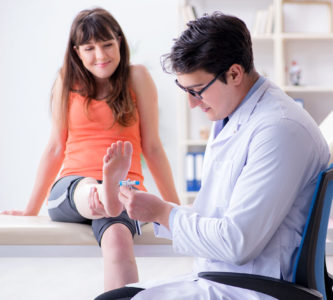 *UPDATE – We are no longer offering virtual visits, as they are no longer covered by insurance*
*UPDATE – We are no longer offering virtual visits, as they are no longer covered by insurance*
Since most people have never visited a foot specialist in their life, the majority of individuals aren’t always sure what signs and symptoms suggest they should seek out medical intervention. While every case is different, there are a couple of symptoms that suggest you’d be wise to consult with an orthopedic specialist to get their opinion. In today’s blog, we take a closer look at what symptoms suggest you ought to visit a foot specialist for diagnosis and treatment.
Signs You Should Visit A Foot Specialist
Increasing Pain – While pain is not normal, it doesn’t always mean that you need to pick up the phone and call the doctor. Pain in the form of soreness is expected after a long day on your feet or after completing a workout. However, if you have consistent pain for days or your dull pain becomes intense and more frequent, it’s a sign that something unusual is going on that should be looked at by a specialist.
Inhibited Gait – If your pain or foot discomfort is affecting the way you walk, it’s time to talk to a foot specialist. If your gait is altered, it will affect how stress is handled in your body. This will increase the load on crucial joints like your hips and knees, and it can also have implications for your spine. Walking with a hitch in your step to avoid pain will increase the likelihood of developing a problem in another key area, so don’t just try to change how you walk to fix the problem, because it won’t work.
Visual Deformity – If you have a visual deformity of your foot, even if it’s not super painful in the moment, you’ll want to have it examined by a specialist to prevent the condition form getting worse, because it will get worse and become painful if left untreated. Two conditions that come to mind when we talk about visual deformities are bunions, which are bony growths on the big toe joint, and hammer toes, which are characterized by the upwards bending of your smaller toes at the joint, rendering them less flexible than normal. If your joints appear bent or bumpy, call a foot doctor.
Feeling Unstable – A number of patients mention that their foot or ankle feels unstable when walking, and this is a big problem for athletes and those with a higher than average fall risk. Many times this is due to underlying ankle instability, but it could also be caused by an arch issue. Either way, left untreated, it can lead to repeat ankle sprains and balance-related issues. See a foot doctor is your feet feel unstable.
Delayed Healing – Finally, if you’ve noticed that cuts, sores or bruising just doesn’t seem to be healing, consider visiting a specialist. This could be a sign of limited blood flow to the area or another health condition like diabetes. Keep an eye on your feet, and if problems seem to continue for longer than expected, talk to a foot doctor.